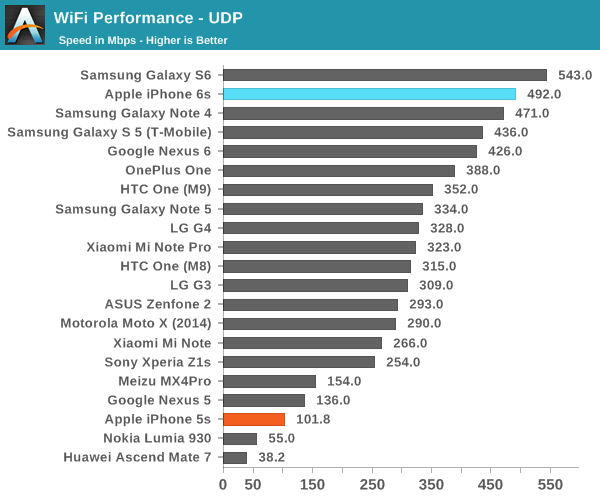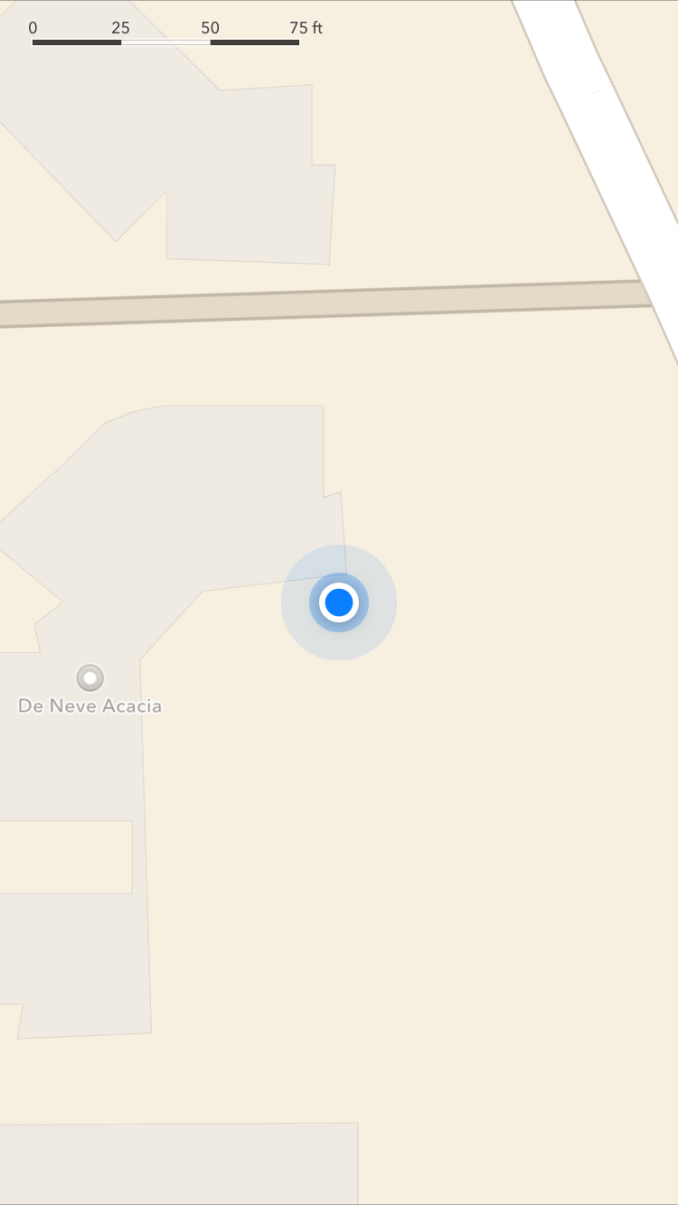The Apple iPhone 6s and iPhone 6s Plus Review
by Ryan Smith & Joshua Ho on November 2, 2015 8:00 AM EST- Posted in
- Smartphones
- Apple
- Mobile
- SoCs
- iPhone 6s
- iPhone 6s Plus
WiFi Performance
While cellular data is often the center of smartphone connectivity, it’s often the case that people rely on WiFi instead of cellular data for the bulk of their data transfers. As a result WiFi is a pretty important part of the overall smartphone experience. In the case of the iPhone 6s, the major change from the iPhone 6 is that rather than single stream 802.11ac, the iPhone 6s now has dual spatial stream 802.11ac. This increases the maximum physical link rate to 867 Mbps. There’s been some confusion over what’s used for the WiFi chipset, and as far as I can tell this is definitely a Broadcom solution, which is identified as BCM4350 in the system judging by the device ID. This chipset is shared with the Macbook, which is probably helpful for driver development. In order to test how well this performs, we use iperf2 in UDP mode to attempt to determine maximum practical bandwidth. It’s worth noting here that the iperf2 ports on iOS are still amazingly buggy though, so these results are no guarantee as far as I can tell.

Interestingly enough, for whatever reason the iPhone 6s holds a minor lead over most of the other devices in this test. I’m not sure what’s causing this, but in practice I found that WiFi on the iPhone 6s worked without any noticeable issues. Reception is noticeably improved when compared to the iPhone 6 due to the addition of a second spatial stream which means that throughput at the same distance is higher.
GNSS
Accurate location is often critical to a number of popular applications for smartphones like any kind of navigation or mapping application, which is going to be an incredibly painful experience if the GNSS system in the phone has poor sensitivity to the signals used in the various GNSS systems available today. Although I have no hard evidence to go on, given the use of a Qualcomm modem in this phone I strongly suspect that this phone is using Qualcomm's IZat location services. I would normally run some cursory testing here with a GPS test application, but because iOS offers no way to clear assistance data and location services are disabled if there is no prior connection to download assistance data, there's no way to do the usual cold lock testing.
A warm lock in which connection was immediately established to begin downloading assistance data achieved lock within 15 seconds, and in general I've never had issues with location services in the iPhone 6s in my time using it.
Misc
Over the course of the review, there are a lot of various bits and pieces that I learn about a phone that might be of interest, but aren’t necessarily examined in intense depth because of either limitations in our testing or the issue of interest isn’t significant enough to examine closely. For example, the fuel gauge appears to be a TI design win as there are references to a BQ27540 chip. The A9 SoC also contains a dedicated AES accelerator for things like full disk encryption and FairPlay DRM. The display backlight appears to use the TI LM3539 driver, but other evidence within the system suggests that this isn’t the only backlight driver for the display.
On the audio side of things, although I haven’t been able to do deep investigations into audio quality it appears in the system that the audio codec used is Cirrus Logic’s CS42L71 which also appears to be responsible for microphone input. However, instead of using an amplified on the audio codec a dedicated amp is used for the speaker, which appears to be a Cirrus Logic CS35L21. Subjectively, the speaker sounds pretty similar to the iPhone 6, but at the high end of the volume range it feels like volume was increased while also increasing distortion. Turning down the volume to a comparable level makes both sound pretty much the same.
More reading of the system files reveals some noticeable codenames like Stockholm which appears to be related to NFC and payments in some way. The fingerprint sensor is referred to as Mesa, and the authentication/secure element appears to be Sand Dollar. The charger chip is referred to either as SN2400 or Tigris. Some sort of accessory detection chip is referred to as TriStar2 or CBTL1610. The ambient light sensor is referred to as CT821 but I can’t find anything on what this is at all.











531 Comments
View All Comments
TitaniK - Friday, November 13, 2015 - link
I used to be so pro android and have tried all main phones on the market; Samsung 3&4, note3,4, htc one m7, nexus 4. I need my phone constantly mainly for business as well as pleasure and at the end, i surrendered to Apple product; so reliable, fast and just clean. It's just a well tuned machine. I compare it this way; android is the NASCAR of mobile devices where Apple is Formula 1. Cars go very fast in both organizations but the Formula 1 machines are simply finer tuned and polished machines.10basetom - Sunday, November 8, 2015 - link
Even though my last two phones have been Androids, I would have to agree with the reviewer's assessment that Android phones have been, more or less, a zero sum game. You can call me jaded, but there's not a single Android phone in the past year that has gotten me truly excited, maybe with the exception of potentially cheaper (relative to YotaPhone 2) dual screen phones coming out of China that would change how you use a phone on a daily basis. PDAF, laser autofocus, and RAW support are nice specs to have for a limited group of photography aficionados, but I don't consider them real innovation in the overall user experience department. Most consumers (i.e., non-geeks) who use phones to take everyday photos will not notice -- or even care -- whether their phone has PDAF or not; and for people who want to take frameable photos, they would probably do so with a tripod and DLSR rather than a mobile phone. Besides, the cameras in the iPhone 6s' are nothing to laugh at.When I think of progress in mobile OS usability, it would have to be something that gives the end user more pleasure in using it, or increase their productivity in a measurable way (e.g., less time in doing something, fewer taps). Maybe I've just been using Android for too long, but there is nothing in Lollipop or what I've seen of Marshmallow that makes me stop and silently shout "damn, that is impressive!". Sure, the interface is a little more streamlined with enhanced jazzy animations (that I turn off anyway to improve performance), and some new iterative features sprinkled here and there, but nothing revolutionary. It's unfortunate that most Android phone manufacturers build a custom skin on top that more often than not makes the phone less usable and more buggy, and also more confusing when you move from one Android phone to the next.
The WinCE-based Neno OS that introduced a 100% swipable interface and weaned people off the stylus two years before the original iPhone -- that's way into revolutionary territory. The pulley menu system in Sailfish OS -- now that's something refreshing. It may not be everybody's cup of tea, but at least they are trying something different, and when you do get used to it, it really does improve one-handed usability. The 3D Touch interface in the new iPhones? Now that's bordering on revolutionary. Again, it may not seem apparent when you first use it, but after living with it for an extended period of time until it becomes habit, you would be hard-pressed to go back to a mobile phone without a pressure-sensitive touch layer. The exciting thing is that we are just scratching the surface of what 3D Touch can bring; and the module could be made thinner and lighter so that future iPhones won't get such a large weight bump.
Other than the superior A9 SoC which has already been widely discussed, the other big thing for me that Android phones have been dropping the ball on is storage architecture. Whereas most Android phones are still advertising eMMC 5.0 storage solutions, the iPhone 6s' have moved way beyond that. Samsung's move to UFS 2.0 is a step in the right direction, and I hope all other Android phone manufacturers will follow suit soon.
dusszz - Monday, November 30, 2015 - link
I've been a long time android user seriously thinking of switching to iphone. Android OS in general is not meant for high end devices because prior to nexus 6p, android is designed for nexus phone which is not a high end devices. The high end iteration of android as in galaxy s6/note 5 with skins feel fragmented and does not really in line with what google intended (material design). Sure they add features with that but it felt like they (high end oem) trying too hard to compete. I always feel the best android devices must come from nexus line but then it does not quite there at least just yet. Every innovation in android OS always feel like it is in beta because the implementation more for marketing rather than useful. For example, nexus 5 has OIS since 2013 but does not feel it has advantage over other phone that has EIS. Furthermore, decision google made to ditch OIS (nexus 6p/5x) further clarify it. I personally never have android phone for more than a year without feeling outdated in term of hardware. So if you think you buy $500 android phone thinking it can compete with iphone, its going to be disappointing. Android is at its best being a midranger.hans_ober - Monday, November 2, 2015 - link
at last!vFunct - Monday, November 2, 2015 - link
I wish he took proper photo tests.Tip: when testing cameras, do make sure to take photos of people. Don't take photos of brick walls.
You're going to find that most people take photos of people with their phones - at parties, selfies, etc..
A good camera test always includes people shots.
vFunct - Monday, November 2, 2015 - link
Basically you're looking for skin-tone reproduction quality.Klug4Pres - Monday, November 2, 2015 - link
I wonder if next year the Home button will disappear, which would help a lot with the bezeltastic design.zeeBomb - Monday, November 2, 2015 - link
That username...lol.I dunno man, the home button is the staple of iPhone Design since the very original. Might be pretty controversial if you'd ask me.
KoolAidMan1 - Tuesday, November 3, 2015 - link
The fingerprint reader is another big reason. If they can get it to be as fast and accurate as it is right now while reducing home button size then I can see them reducing the bottom bezel.Otherwise you're looking at making their fingerprint reader as flaky and undependable as Samsung or everyone else's
Tetracycloide - Tuesday, November 3, 2015 - link
The nexus 5x has been super solid.